
The 2020 Audi RS5 Facelift Requires A Sharp Eye To Find The Changes
- Dec 12, 2019
- Views : 4858

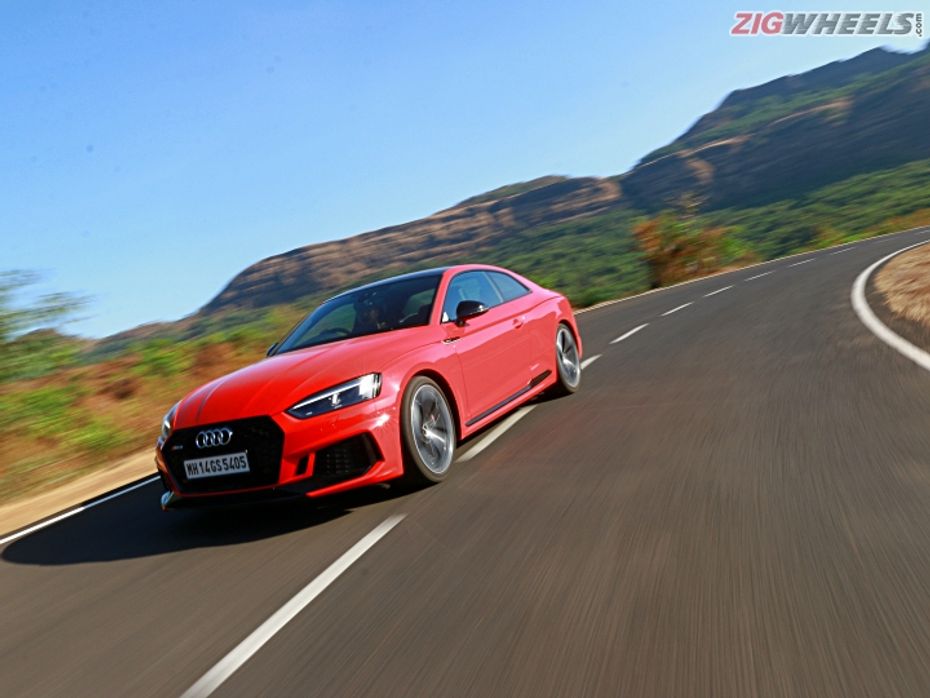
The last generation Audi RS5, launched way back in 2010, was a force to be reckoned with. Sure, it hailed from one of the most sensible countries on the planet, but it did have an irrational side to it. It had two fewer doors than its A5 sibling, rear seats best reserved for children and a massive 4.2-litre V8 that made more power than the donor car, the first-gen Audi R8. The new one, on paper at least, doesn’t feel so appealing anymore.
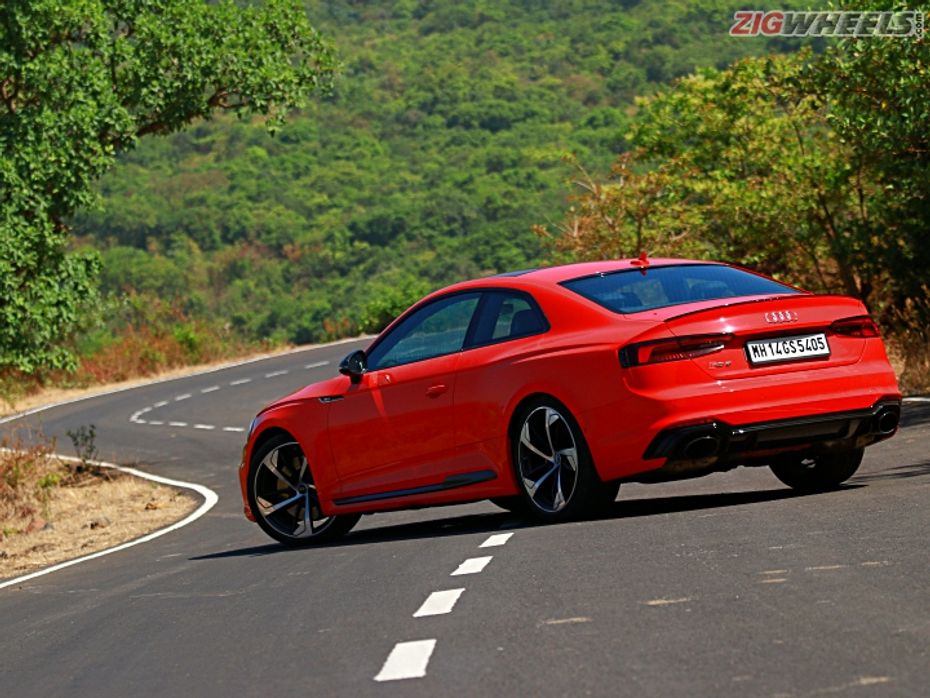
The old RS5 had an engine made of pure evil that was built to seduce the hearts of petrolheads, It could rev way past 8000rpm and made a sound that felt like a machine gun firing at full tilt. The new one seems more civilised, though. The engine has been downsized significantly and is now twin-turbocharged (did we just hear the Gods gasp?) and to add to the blasphemy, it is now a V6 and not a V8. So has the RS5 really lost all its muscle or are we just crying wolf?
Why the fuss?
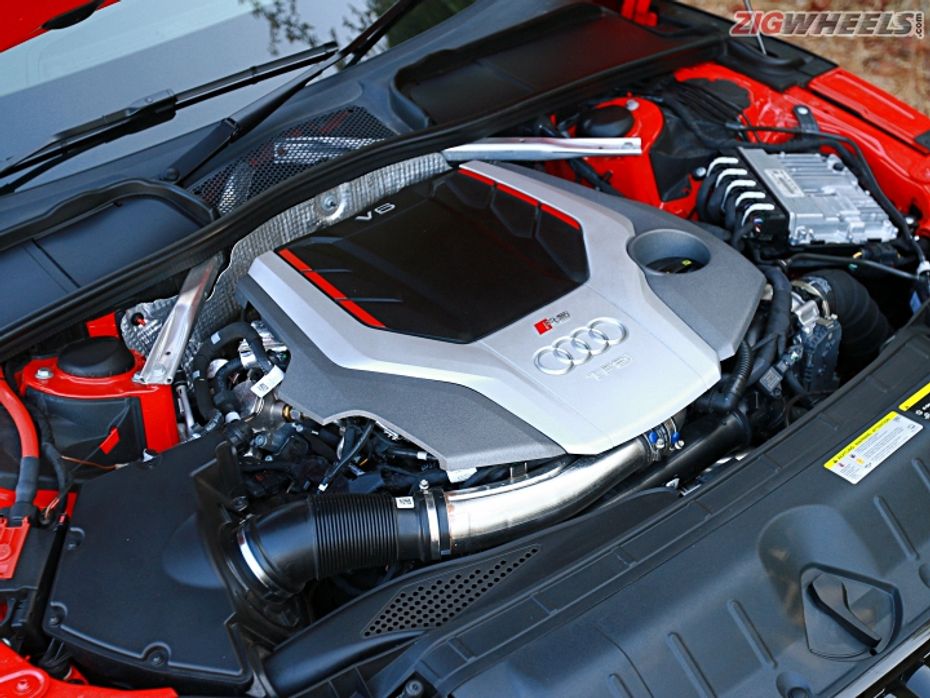
Normally we would begin with the aesthetics of the car, but the RS5 is not a normal car and this is not a normal test. So, we shall begin straight away with the engine. The new RS5 displaces just 2.9-litres in a V6 configuration and is complemented by two turbos that are housed within the V-bank rather than on either side of the block. This, according to Audi, heats up the catalysts way faster, and thanks to the shorter distances between the turbos, the exhaust valves and the catalyst, turbo lag is almost negligible. Less plumbing also means there’s less weight and better efficiency. So it’s a clever little engine then.
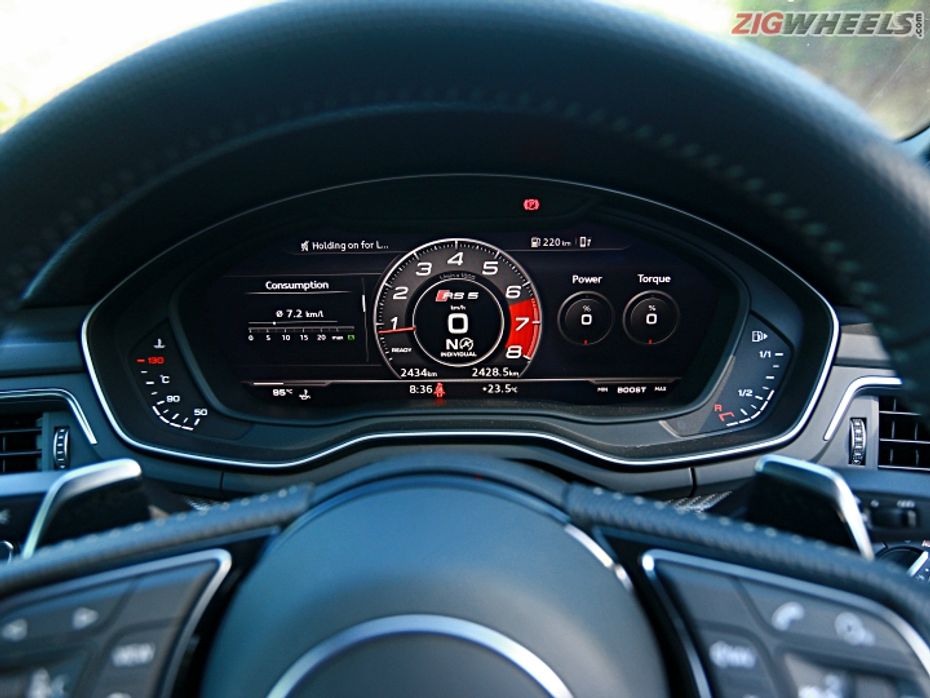
The power remains unchanged at 450PS. However, it now peaks at 6700rpm compared to the eye-watering, smile-inducing and completely bonkers 8250rpm mark in the older car. The torque, on the other hand, is a different matter altogether. Where the old car made 430Nm, the beast in red we have here makes a whopping 600Nm of it. And most of it is available between 1900rpm and 5000rpm when compared to 4000-6000rpm in the older car. This fact alone should make it evident that the new RS is more focused towards delivering a strong mid-range to devour the miles rather than carving apexes on the race track.
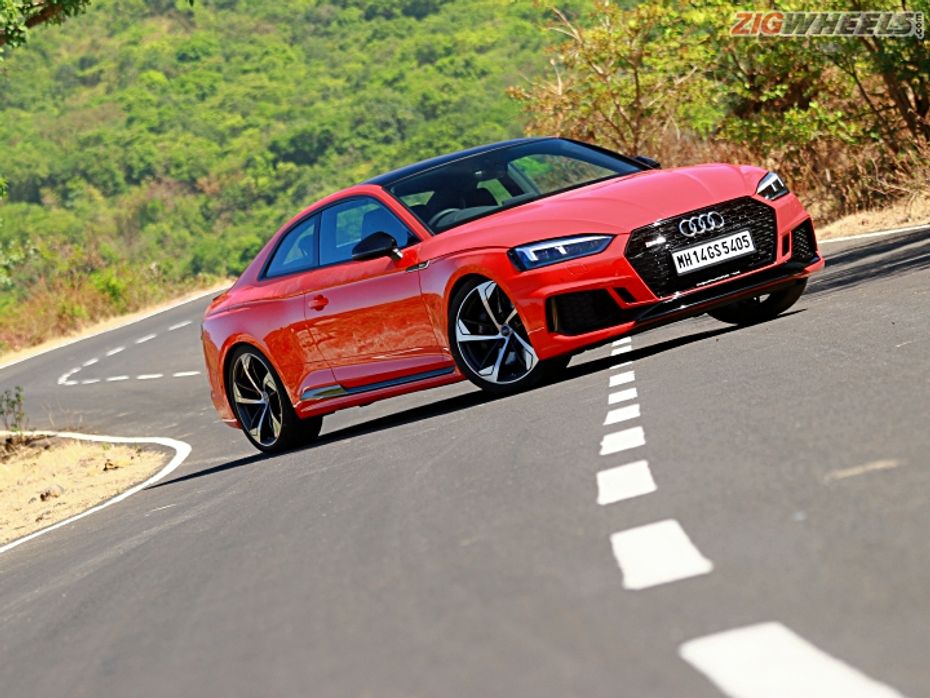
Oddly enough, the engine is mated to a traditional 8-speed torque converter automatic transmission rather than a DCT (dual-clutch transmission). But this is a ZF unit, so it is far from slow. In fact, it is rather intuitive. The transmission is connected to Audi’s incredible quattro AWD system, which is primarily rear biased but can supply over half the torque to the front wheels via the torque vectoring system.
It must be fast?
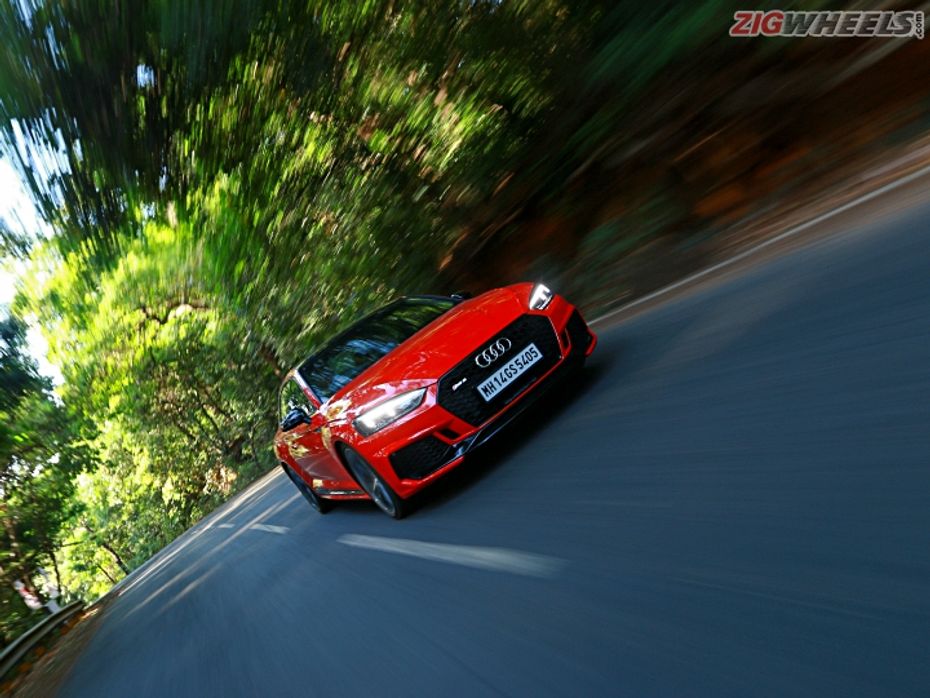
No, it's ballistic. The moment you step onto the throttle, the response is almost immediate. You don’t need to wait for the revs to build. As soon as the tacho nudges past the 2000rpm mark, the RS feels like it’s been released from a slingshot. The acceleration is so vicious you feel your head being pushed into the headrest by an invisible but powerful hand. And that’s still the Comfort mode. Speaking of modes, the RS5 comes with three driving modes - Comfort, Dynamic and Individual. In Comfort, the throttle response is less urgent, the gear changes less aggressive and the sound more peaceful. Relatively speaking, of course. In Dynamic mode, the engine simply unleashes itself. The throttle response is snappy and razor-sharp, the steering response is sharper and more direct and the gear changes become faster too.
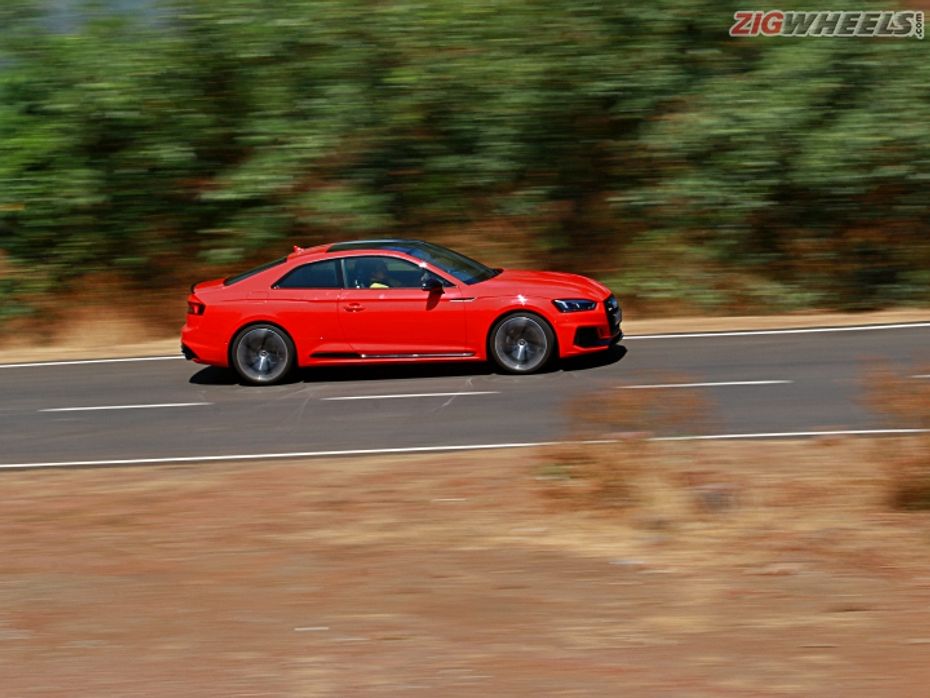
In the Individual mode, you can set these parameters yourself. There is, however, no option to toggle between suspension setups. Throttle maps and steering adjustment are all you get. We recorded a 0-100kmph time of 4.2 seconds in Dynamic mode, which is blisteringly quick for a car that can seat four passengers and has a boot big enough to swallow their luggage. The let down here though is the sound. Even at full clip with all valves open, it sounds nowhere near as majestic as the old V8 RS5. The sound is sporty and has a good bass. There’s great overrun every time you roll off the throttle too. However, it sounds artificial and not mechanical, like in the older car.
What’s it like to drive?

Quite likeable honestly. For starters, the suspension is setup right in the middle of stiff and soft. It is perfectly balanced and surprisingly supple for city driving. On the bumpy roads of Pune, the RS5 rarely felt out of shape. The suspension soaked up almost all undulations with minimal fuss despite riding on 20-inch wheels. Even the larger speed breakers posed little threat as the ground clearance proved to be just about enough, though we had to be very careful while navigating through them. It tends to feel jumpy only on the very bumpy sections, especially between 20-40kmph. Prod the accelerator and the ride smoothens out by a fair margin. Out on the highway, it is a treat to drive. It stays planted and sure-footed at all times, That said, it is not too fond of concrete and tends to waver a bit at high speeds. But boy does it love the tarmac.

On our drive up to Lonavala, the RS5 stuck to the corners like a strip of Velcro. The flat-bottom steering is direct, feels great to hold and is very responsive. The slightest tick, and the nose darts towards the intended direction. Follow it up with a prod of the right foot, and the RS5 powers out of the corner with a fistful of fury, torque and exhaust noise. It loves to rev and, in manual mode, will stick to a gear until you shift up yourself and the results are oh so rewarding.
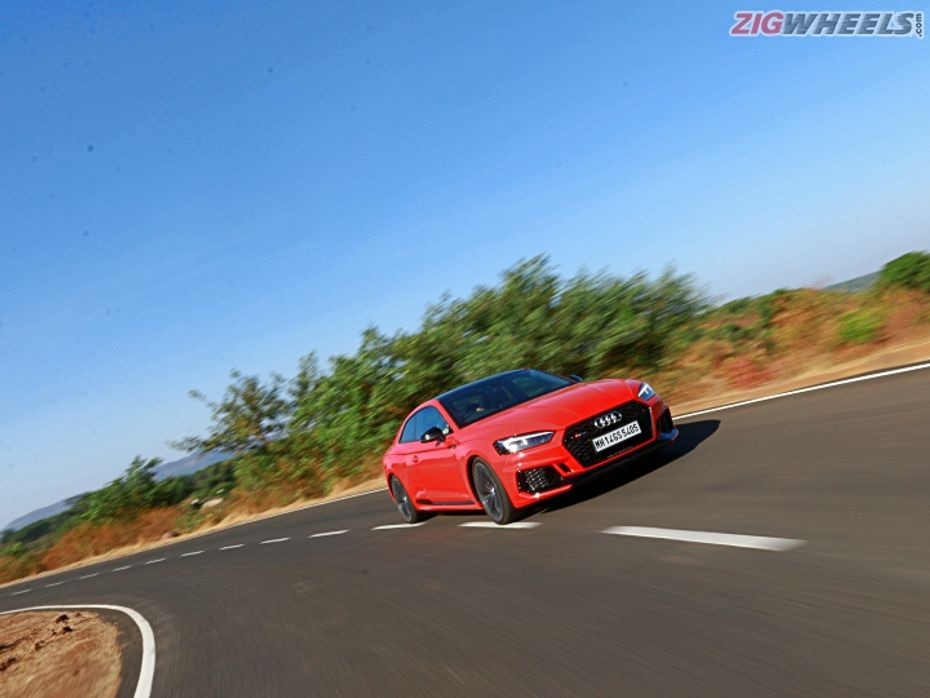
The Quattro system with torque vectoring sorts almost everything out as it supplies power to the wheels that have the most traction so you never run out of grip. It seems to to be tuned for understeer. Even with the traction control off, the RS never feels out of shape or snappy, even if you’re too hot into a corner, it will understeer, giving you plenty of room to apply the brakes and correct your error. It only snaps back to oversteer when you’re really trying to test its limits and lift off the throttle after turning too hard. But even then, it catches its tail in no time. So you do get the feeling that the TC you turned off, was never really off in the first place.
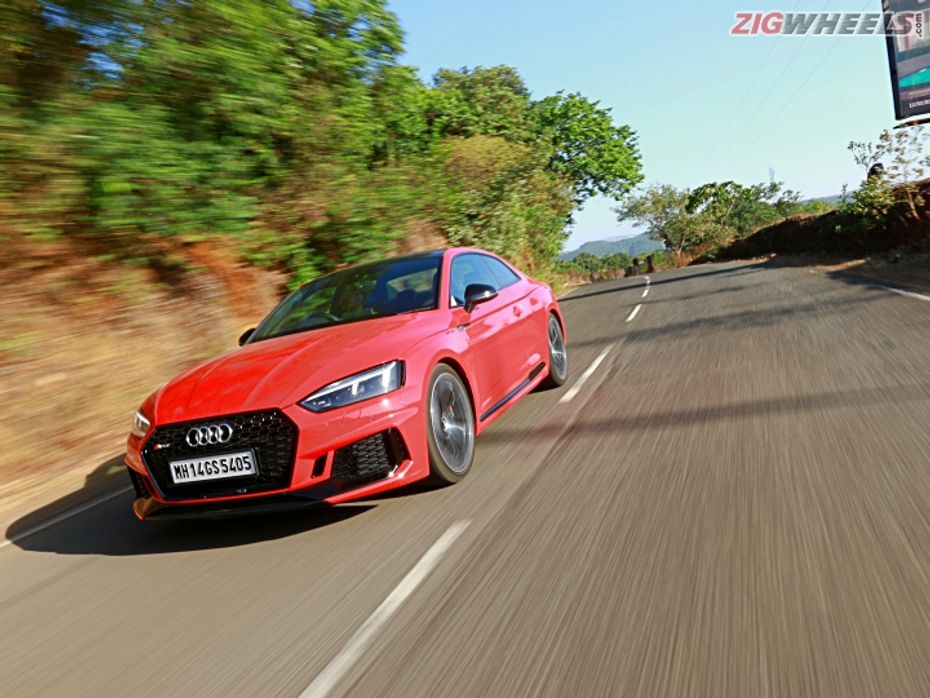
I will admit though, the dynamic mode does prove to be a bit of a handful for our road conditions. The throttle is too snappy and the moment you lift off the pedal you feel the jerk as the car goes into engine braking. Though it was thoroughly fun on the winding, twisting roads leading to Amby Valley, it was hard work. Plus, since the suspension is a bit of a compromise between sportiness and comfort, the RS5 does begin to show its dislike for rapid direction changes especially when you push it hard. That’s when you notice that the car is almost never flat through the corners. And the harder you push, the more it starts to understeer, especially when it feels the rear is beginning to slip. Plus, the steering, though well weighed, has limited feel to it and when the going goes really fast, tends to feel vague and you never get a sense of what the tyres are up to.
But, switch to individual mode, set the steering and sound in dynamic and the powertrain in comfort and you can have fun on the twists without being on edge. The RS5 is the car you enjoy the scenery in and not leave it as a blur. You can sit on the highway at 100kmph in 8th with the needle barely breaching 1600rpm.
Yo, you forgot the brakes
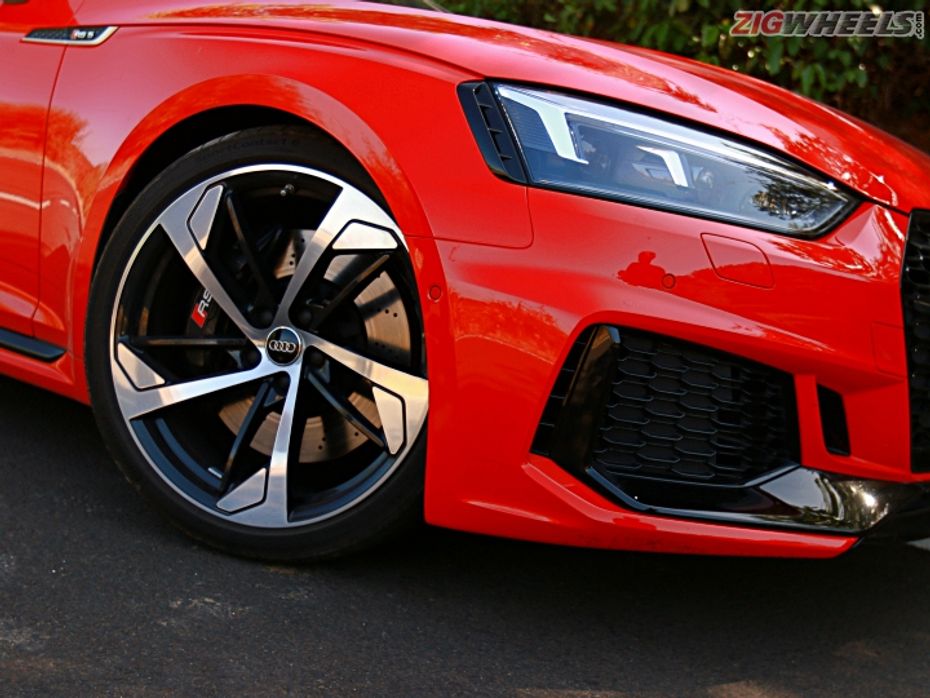
Oh yeah, right the brakes. The brakes work really well, they are progressive and provide plenty of feel, much more than the steering which helps inspire driver confidence in the corners especially while driving down a hilly road. The bite from the ventilated discs is enough to bring this 1.7-tonne hunk of muscle to a standstill from 80kmph in just 2.18 seconds and the 100-0kmph takes just 2.65 seconds. The braking force isn’t face-tearing but you do feel the forces of nature acting against your body. The feeling is more exciting than it is unsettling.
But is it comfortable?
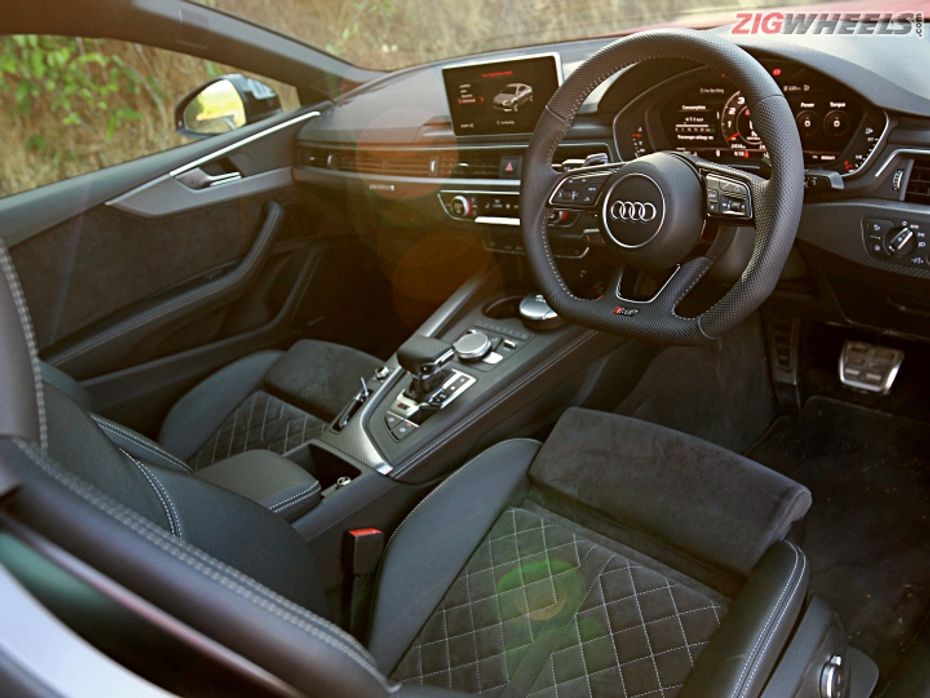
Yes, very, it is a proper grand tourer, there is no doubt about it. The cabin is bathed in leather and Alcantara, there is no carbon-fibre to speak of, however, which is oddly refreshing. It lets you know immediately that it prefers open roads rather than apexes and run-off areas.
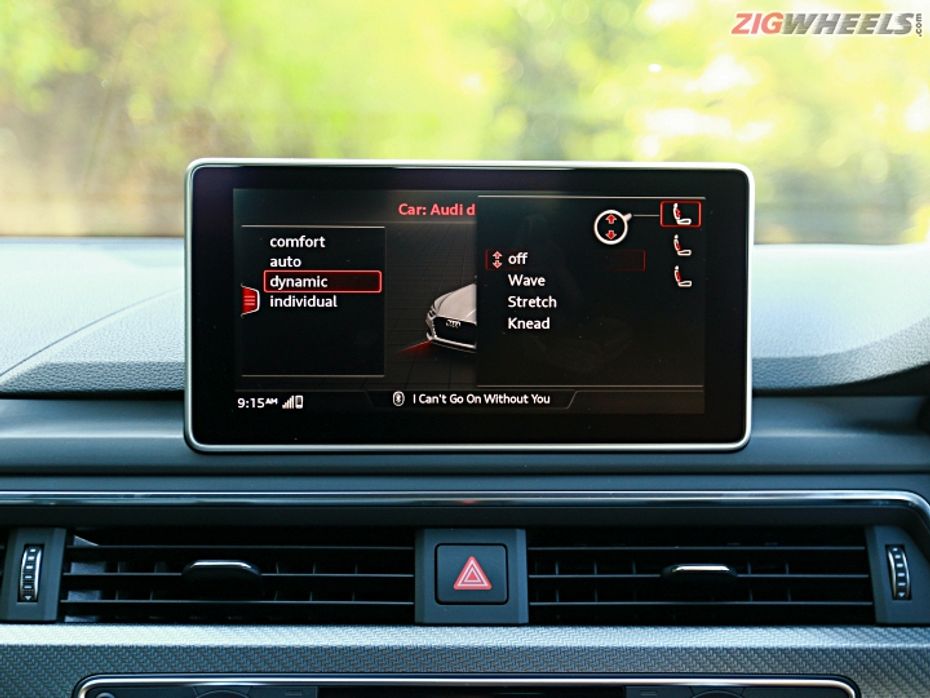
In the front, you get 925-1180mm of legroom coupled with 945mm of max headroom which is enough to fit the tallest of passengers. And with 1400mm of shoulder room in the front, the width of the passengers isn’t a problem either. Plus, you get fully adjustable front bucket seats with adjustable wings, adjustable squabs (extendable to 545mm from 500mm) for both passenger and the driver which makes it that much easier to find your perfect seating position. Plus, you also get massage function with varying formats and three levels of intensity for front occupants and it is operated via the lumbar adjustment system.
The rear of the car is not as spacious but isn’t cramped. Though, you can seat only two, at 900mm the headroom is adequate for average sized adults. The seat squabs however at 455mm in length don’t provide as much under-thigh support as desired and can make long hauls in the car a bit uncomfortable, kids though will feel quite happy with the setup.
What about equipment?

It’s all there. The MMI system is in place like all Audis, and it comes with Apple CarPlay connectivity and all the other features like Bluetooth, vehicle settings, internal data storage, the works. It also comes with its own navigation system which isn’t the most intuitive and takes quite a while to get used to. Plus, you also get parking assist and Audi’s virtual cockpit instrument cluster which is just phenomenal to look at.
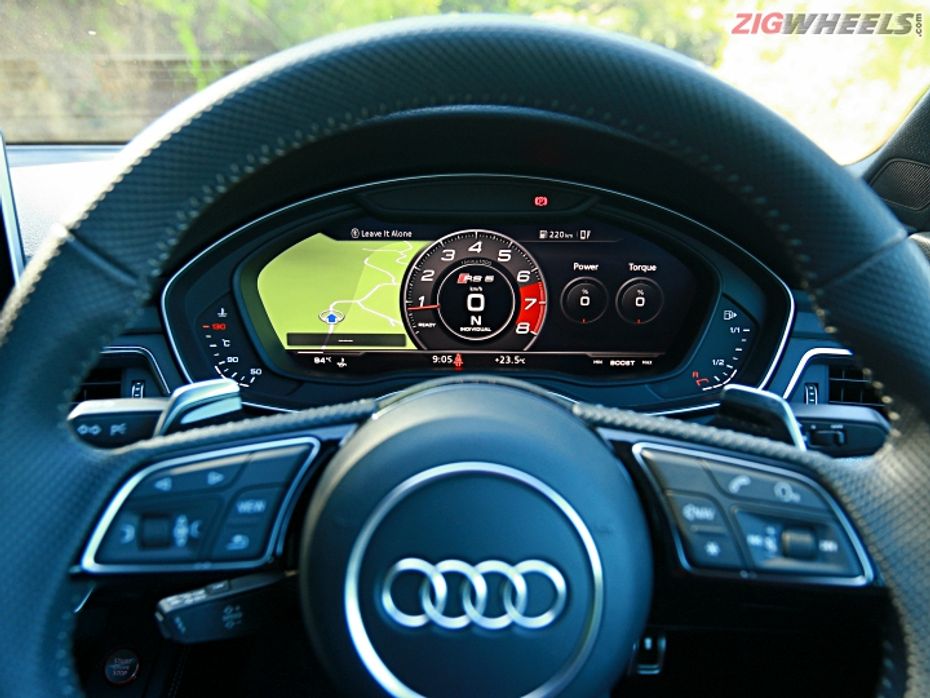
It allows you to view information the way you want to view it. But our favourite view is the analogue tachometer in the middle of the screen with the digital speedo in the centre of the tacho dial. Plus, on the move, when you drive hard, the tacho lights up with a green accent at the 5000rpm mark indicating the best place to shift up to get the most amount of power down.
How does it look?
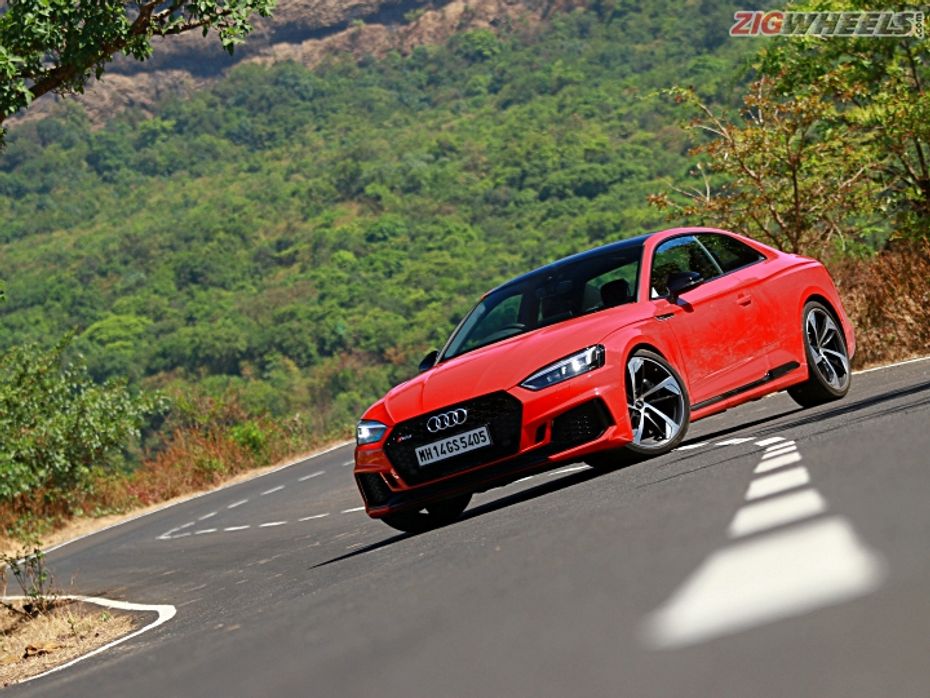
In one word, a head-turner, especially in that beautiful red hue, you will find almost everyone giving the car at least a second look. Where the design of the old RS5 felt like an add-on job, this looks like it was built to look like it does. The massive front hexagonal grille lets you know immediately that this is something special. The long bonnet with a leaned back cabin makes the RS5 look like a muscle car. A v6 powered muscle car but a muscle car nonetheless.

Then there the 20-inch wheels which look absolutely gorgeous, design wise, the car is right on point. When you buy a car like the RS5, you want people to notice it, and this will never fly under the radar.
Should I buy one?
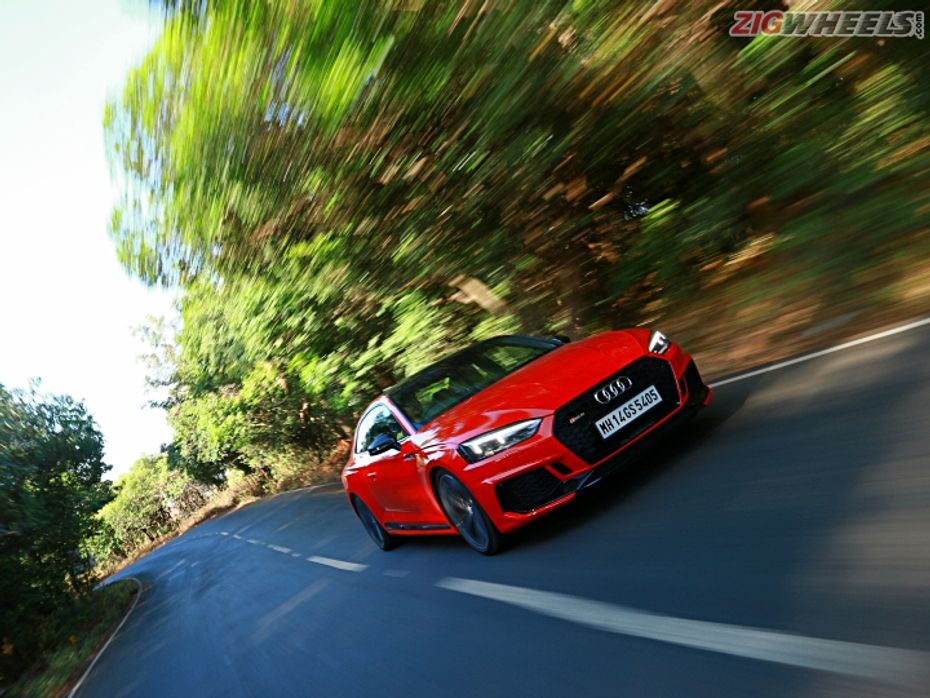
That is a tricky one, the old car was more of a purist’s machine. The naturally aspirated V8 felt mechanical and reaching 100kmph in that thing felt like an occasion. It would feel heavy under braking and if you were not careful, it would misbehave in the corners. But that eventfulness was what made it special. There was rarely a dull moment in it and you always wanted to poke it here and prod it there just to see how it would react. The new RS5, on the other hand, has no such hang-ups. It feels digital and sometimes even a little artificial. But we can’t fault it for having no real issues.

Yes, it feels a bit digital, but you still can’t take away from the fact that it is a very capable car and an all-rounder. It’s fast, it’s comfortable in the city and can munch miles all day long while consuming relatively less fuel. And it would make quite the entrance at parties. In essence, it is the perfect car for someone who likes his weekend trips but doesn’t want something too serious like the BMW M4. Plus, at Rs 1.11 crore ex-showroom India, it is also the most affordable among its competition. Still, a V8 would’ve made the deal infinitely sweeter

The 2020 Audi RS5 Facelift Requires A Sharp Eye To Find The Changes

2018 Audi Q5: First Drive Review

Audi Unveils e-tron Electric Prototype At Geneva Motor Show 2018

Audi Launches Bonkers RS 5 Coupe At A Bonkers Price
 Land Rover Defender
Land Rover Defender
 Volvo XC90
Volvo XC90
 Toyota Vellfire
Toyota Vellfire
 BMW X7
BMW X7
 Land Rover Range Rover Velar
Land Rover Range Rover Velar
India's largest automotive community
 No More Diesel-iMT Powertrain In India, As Kia Discontinues It For The Sonet, Seltos And Carens
No More Diesel-iMT Powertrain In India, As Kia Discontinues It For The Sonet, Seltos And Carens
 Hyundai Creta Electric: Things You Get With Each Of Its 5 Variants
Hyundai Creta Electric: Things You Get With Each Of Its 5 Variants
 Here Are Some Adrenaline Pumping Experiences From Auto Expo 2025 That You Should Not Miss!
Here Are Some Adrenaline Pumping Experiences From Auto Expo 2025 That You Should Not Miss!
 All You Need To Know About The Surprise Element At Auto Expo 2025: BMW iX1 LWB
All You Need To Know About The Surprise Element At Auto Expo 2025: BMW iX1 LWB
 Audi A4
Rs. 46.99 Lakh
Audi A4
Rs. 46.99 Lakh
 Audi Q7
Rs. 88.70 Lakh
Audi Q7
Rs. 88.70 Lakh
 Audi Q5
Rs. 66.99 Lakh
Audi Q5
Rs. 66.99 Lakh
 Audi Q3
Rs. 44.99 Lakh
Audi Q3
Rs. 44.99 Lakh
 Audi A6
Rs. 65.72 Lakh
Audi A6
Rs. 65.72 Lakh
 Land Rover Range Rover
Rs. 2.36 Crore
Land Rover Range Rover
Rs. 2.36 Crore
 Volvo XC90
Rs. 1.00 Crore
Volvo XC90
Rs. 1.00 Crore
 Mercedes-Benz GLA
Rs. 50.80 Lakh
Mercedes-Benz GLA
Rs. 50.80 Lakh
 Toyota Vellfire
Rs. 1.22 Crore
Toyota Vellfire
Rs. 1.22 Crore
 Porsche 911
Rs. 1.98 Crore
Porsche 911
Rs. 1.98 Crore